According to the minutes of their January meeting, released on Wednesday, Federal Reserve officials expressed caution about cutting interest rates and stressed the need for further progress in inflation before making any adjustments.
Policymakers expressed concern over President Donald Trump’s proposed tariffs, and their potential impact upon consumer prices. This could complicate efforts by the Fed to bring inflation under better control.
The Federal Open Market Committee, or FOMC, unanimously decided that the federal funds rate would remain unchanged after three consecutive reductions in 2024. These cuts had reduced rates by an entire percentage point.
Officials at the Fed have stressed that, while they acknowledge that monetary policy has become less restrictive, current conditions give them time to evaluate economic trends and take further action.
The committee members noted that while inflation is showing signs of moderating, it remains above the Fed’s 2% target.
The committee noted that current policy was “significantly less restrictive than it had been before the rate cuts”, giving members time to evaluate the situation before taking any further action.
Trump tariffs could complicate the inflation fight
One of the most important uncertainties discussed at the meeting was the possible inflationary effect of Trump’s trade policies.
The president has already imposed a few tariffs, but recently suggested that they be expanded, including a 25 percent duty on automobiles and pharmaceuticals.
Such measures could escalate trade tensions, and lead to higher costs for consumers and businesses.
FOMC members noted that firms in different industries had already indicated that they would pass higher input costs on to consumers.
The summary of the meeting highlighted concerns about “potential changes to trade and immigration policies,” which officials claimed could pose “side risks to inflation outlook.”
Market analysts believe the Fed could delay reducing rates longer than expected if tariffs cause prices to rise significantly.
The Fed has not made any firm commitments, despite the fact that financial markets have already priced in a rate reduction by July or September.
Officials seem content to wait and see, assessing inflation trends prior to making any further moves.
Tax cuts and reduced regulations can boost investment
Officials at the Fed acknowledged that despite concerns about inflation and trade disruptions under Trump’s administration, certain policy changes could support economic growth.
Tax cuts and reduced regulation were cited as factors that may boost business investment and hiring.
However, inflation data remains mixed.
Consumer prices rose faster than expected in January, indicating persistent cost pressures. Wholesale price trends also showed signs of ease.
These contradictory signals reinforce the Fed’s cautious stance.
Jerome Powell, Fed Chair, has refrained from making any speculations on the impact of Trump’s tariffs on inflation.
Other Fed officials have expressed concern that prolonged trade disruptions may force the central bank into maintaining higher rates for a longer period.
The Fed is not in a hurry to make any immediate changes, as the federal funds rate is currently set at between 4.25% and 4%.
The central bank will have to decide in the coming months whether it will continue to cut rates or if it will remain on hold due to economic uncertainty, including changes in trade policy.
This post FOMC Minutes shows Fed cautious on rate reductions as tariff-led inflation fears persist and may be modified as new updates unfold
This site is for entertainment only. Click here to read more






